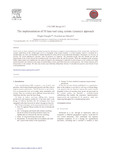JavaScript is disabled for your browser. Some features of this site may not work without it.
| dc.contributor.author | Omogbai, Oleghe | |
| dc.contributor.author | Salonitis, Konstantinos | |
| dc.date.accessioned | 2017-06-02T14:47:02Z | |
| dc.date.available | 2017-06-02T14:47:02Z | |
| dc.date.issued | 2017-05-09 | |
| dc.identifier.citation | Oleghe Omogbai, Konstantinos Salonitis, The implementation of 5S lean tool using system dynamics approach, Procedia CIRP, Volume 60, 2017, Pages 380-385 | en_UK |
| dc.identifier.issn | 2212-8271 | |
| dc.identifier.uri | http://dx.doi.org/10.1016/j.procir.2017.01.057 | |
| dc.identifier.uri | https://dspace.lib.cranfield.ac.uk/handle/1826/11962 | |
| dc.description.abstract | The 5S (sort, set, shine, standardize and sustain) lean tool has been known to improve system performance. In the current study, the short run dynamic implications of the sorting aspect of 5S is investigated using system dynamics. A system dynamics model is developed for a manufacturing case study and simulated to establish the effect of sorting activity on manufacturing throughput. The purpose was to assess, in advance, the system performance outcomes when 5S practices are improved. The simulation results were the stimulus for real life improvements in the system because the simulation results were able to mimic the real-life outcomes. While the simulation results encourage further improvements to be implemented, the model developed in the current paper is replicable in other instances as the variables used in the model are generic and common to most types of manufacturing systems, particularly those new to lean practices. The dynamic analyses of 5S lean practices is not common. The study also reveals some interesting relationships between 5S and other lean practices and between 5S and system performance. | en_UK |
| dc.language.iso | en | en_UK |
| dc.publisher | Elsevier | en_UK |
| dc.rights | Attribution-Non-Commercial-No Derivatives 4.0 Unported (CC BY-NC-ND 4.0). You are free to: Share — copy and redistribute the material in any medium or format. The licensor cannot revoke these freedoms as long as you follow the license terms. Under the following terms: Attribution — You must give appropriate credit, provide a link to the license, and indicate if changes were made. You may do so in any reasonable manner, but not in any way that suggests the licensor endorses you or your use. Information: Non-Commercial — You may not use the material for commercial purposes. No Derivatives — If you remix, transform, or build upon the material, you may not distribute the modified material. No additional restrictions — You may not apply legal terms or technological measures that legally restrict others from doing anything the license permits. | |
| dc.title | The implementation of 5S lean tool using system dynamics approach | en_UK |
| dc.type | Article | en_UK |
Files in this item
This item appears in the following Collection(s)
-
Staff publications (SATM) [4364]
